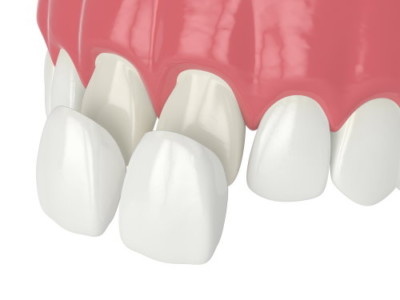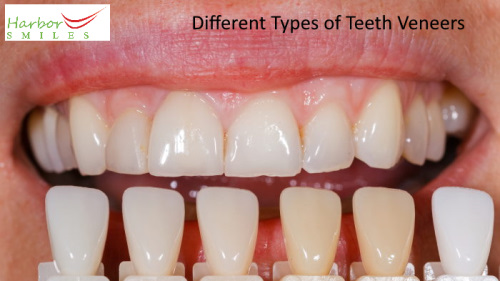Contents: Procedure | When To Use? | Advantages & Limitations | Aftercare | How much cost? | Appointment | FAQ
 Dental veneers are often constructed of resin or porcelain composites and are super thin shells or laminates. These are around half a millimeter thick so these tend to not be visible. These are applied through the teeth by removing an equal thickness of enamel from the veneers. These are mostly used to hide or correct teeth imperfections. The porcelain veneers are more translucent which gives a more natural appearance of the original enamel; thus, reflecting a more natural smile. However, porcelain is often brittle and relies heavily on the underlying enamel to provide the needed strength and support.
Dental veneers are often constructed of resin or porcelain composites and are super thin shells or laminates. These are around half a millimeter thick so these tend to not be visible. These are applied through the teeth by removing an equal thickness of enamel from the veneers. These are mostly used to hide or correct teeth imperfections. The porcelain veneers are more translucent which gives a more natural appearance of the original enamel; thus, reflecting a more natural smile. However, porcelain is often brittle and relies heavily on the underlying enamel to provide the needed strength and support.
While the process of removing a layer of enamel may seem uncomfortable, it is generally painless. According to the American Academy of Cosmetic Dentistry, patients may experience some tooth sensitivity during the first few weeks following the procedure. This is normal due to the shaving of the tooth enamel. Know about misalignment of the jaw and over bite.
This Cosmetic dentistry treatment is mostly used to improve the looks of the teeth which is why it is commonly performed on the front tooth only. It won’t be of any use at the back molars as it is not directly visible. In addition, it is not an excellent solution to missing teeth as dental implants are a much better option. Know about diastema to correct gaps between teeth.
Types of Veneers
Porcelain Veneers
Porcelain veneers are an excellent choice for patients who only want minor changes in their teeth such as the shape, size, and color. It is also the most aesthetic type of veneers and has less harmful material for dental restorations. Porcelain veneers can last longer than any other types of veneers. The porcelain laminates rarely cause harm to the wearer and the surrounding tissues of their mouth (biocompatible). These types of veneers can greatly improve the appearance of the patient’s smile since it offers a more natural look and its color closely matches the natural color of your teeth. Porcelain veneers may be a permanent solution, but it requires shaving a few millimeters of the tooth before placement.
Composite Veneers
Patients love composite veneers since it is the most cost-effective solution to bringing their natural smile back. It can also be placed in one treatment which means no need for a second visit to the dentist to have this installed to your teeth.
Composite veneers are made of composite resin – a material made of both organic and inorganic materials. The natural materials include the initiator, the resin, and the coupling agent. The inorganic materials used for this treatment is the filler. The bonding material used to make composite resin is the same to the tooth-colored dental fillings. Even if it is strong, composite veneers are not as durable compared to its porcelain counterpart, but composite costs less than porcelain. Another drawback of this material is that it does not blend well to the natural color of the tooth and is prone to staining. Additionally, composite veneers do not last long. This type of veneers are permanent and may require you to shave a few millimeters of your tooth enamel.
Lumineers
Lumineers are a brand name for porcelain veneers. It is a permanent cosmetic solution made of very thin porcelain laminate material and it requires minimal preparation. Unlike standard porcelain veneers, less natural tooth structure will be removed in order to place the Lumineer over your tooth.
Lumineers are mostly used for treating discolored or irregularly shaped teeth. These are smoother, look more natural, and it feels more natural. Lumineers can also be reversed, but it doesn’t last as long.
Process
When compared to direct bonding, the installation of veneers is very involved. The procedure will involve three steps:
- Consultation
- Preparation of the patient’s mouth as well as creating impressions
- The actual application of the veneers.
The entire process will normally take two to three visits. Additionally, this is dependent on whether a separate appointment is required.
Consultation and planning stage
This happens during our skilled dentist’s initial consultation with the patient. During the initial consultation, the patient is free to explain any oral issues they might have or what they want to achieve to our dentist who will then determine if the patient is a good candidate for the treatment.
Porcelain may be an expensive type of veneer to some, but do not worry since there are other types of veneers to choose from. You can choose a more inexpensive composite veneer or other types of veneer. It is also crucial to address the patient’s bite problem first. Aside from that, the patient will be given a step-by-step comprehensive explanation about the different restorative/cosmetic options available as well as a breakdown of how much each will cost.
Mouth preparation and impression creation
The following visit will concentrate on two major phases in the procedure:
Preparing the patient’s mouth
The procedure will include scraping away a thin coating of enamel – equivalent in thickness to the suggested veneers. Do take note that porcelain takes less amount of enamel material taken off compared to other materials. If the teeth are crooked or crowded, more enamel may be removed, particularly on the sides of the affected section. Due to the trimming of the enamel layer, the gums may become damaged. This will result in some sensitivity and pain for the first several days and will continue until the damaged area is completely healed. You should not be concerned because your gums will begin to heal shortly afterward and you will resume normal function within a few days. Moreover, if the patient has partially broken teeth, they should be restored first before going on with the veneer application.
Creating impressions
After the preparation of the patient’s mouth, we will start making impressions. The created impressions along with the material and color preference are sent to the lab for manufacturing. The laboratory will create it as per the dentist’s directions and the dental impressions. The entire process will last for 10 days, which overlaps with the healing of the gums. Therefore, it is easier to fit onto the patient’s teeth.
Application
This last step will occur after the impressions are completed in the lab which can take up to 10 days. The patient’s teeth will be cleaned and polished again, and then chemically scraped to smoothen the surface, which will aid in the dental bonding process. Next, the veneers will be attached using clear cement. When applying porcelain to a stained tooth, transparent cement is utilized to conceal the discoloration. The cement will match the adjacent teeth so it looks more natural. After the application is approved, the patient is requested to seal their mouth to ensure that the top teeth fit comfortably against the lower teeth. Learn more about anterior teeth and treatment.
When to use?
These are mainly used for cosmetic purposes and there are several situations where it will be advised by your dentist.
These are the most common situations:
Tooth discoloration
Tooth discoloration is a common occurrence in men and women. There are various reasons our teeth get discolored. Smoking, drinking alcohol, coffee, and poor oral hygiene are just some of the many reasons for discoloration. Also, did you know that consuming too much fluoride can also cause discoloration? There are also other factors such as gastric reflux, drug usage, large resin fillings, or root canal treatment that can contribute to discoloration. Sometimes teeth whitening solutions may work, but it can only work to some extent. When the teeth are deeply stained or have permanent white or yellow spots, it can only be covered with veneer.
Worn-out tooth
Your teeth will eventually wear out just like most of the parts of your body. The primary reason it occurs more rapidly is a lack of dental hygiene. There are, however, several reasons for this, including diabetes, heredity, and fluoride deficiency.
Chipped or cracked tooth
They may be able to assist in the repair of chipped or fractured teeth. To conceal chipped or fractured teeth, one or more indirect veneers may be placed.
Gaps
If patients have minor gaps in the teeth, this can help greatly to cover it up. If the gap is too big or it is a bit crooked then, orthodontics treatment such as metal braces is a better alternative than veneers.
Irregularly-shaped, or misaligned teeth
Not all are born with a flawless set of sparkling teeth, and once the trimming is complete, dental veneers can be utilized to conceal the affected area. This condition includes teeth with unequal width or height as well as surfaces that have depressions or bulges in the front.
Pros and Cons of Veneers
Advantages:
- It can help to restore the natural appearance of the affected tooth.
- They are readily absorbed by the gum tissues. Also, this type of veneer is able to resist stains better.
- They are perfect for those with stained or discolored teeth.
- Porcelain comes in various colors. Thanks to this even dark-looking teeth can hide under the pearly white smile of porcelain veneers.
- In comparison to crowns, they need less contouring, making them a more attractive cosmetic dental choice.
- The procedure does not require any amount of bone loss.
- They don’t use any metal in any step of the procedure.
Limitations:
While they are relatively safe and the most famous cosmetic procedure available, they, like other procedures, have a few drawbacks:
- To apply veneers, a thin layer of enamel must be removed from the patient’s teeth. Once it is removed, it can no longer be restored.
- Compared to other types of cosmetic dentistry procedures, these are on the pricier side.
- They are not easy to fix and have limited repairability.
- Since an enamel layer is removed, expect to have slight tooth sensitivity and it can be felt during the first few weeks.
- When installed, the color of veneers cannot be changed; therefore tooth whitening is essential before the application.
- Though this rarely happens, there are cases where veneers have dislodged or even fall off. This is precisely why dentists encourage patients to abstain from consuming hard foods following the operation.
- They must be restored with a full dental crown if tooth decay occurs.
When Are They Not Suitable?
Veneers are not encouraged for people whose teeth are compromised by decay, gum diseases, cracks, massive fillings, or a lack of enamel thickness. People who usually grind their teeth are also susceptible to having the prosthetic cracked or chipped. It is vital that you discuss any dental concerns you may have with your dentist.
Aftercare
 It is typically a painless treatment due to the use of a local anesthetic during the first preparation. If there is pain after the procedure, dentists will prescribe you over-the-counter pain medication. It is common for your teeth to be sensitive afterward and will remain like that for several weeks as they adjust to the veneers. Expect it to hurt when you consume hot or cold foods and drinks.
It is typically a painless treatment due to the use of a local anesthetic during the first preparation. If there is pain after the procedure, dentists will prescribe you over-the-counter pain medication. It is common for your teeth to be sensitive afterward and will remain like that for several weeks as they adjust to the veneers. Expect it to hurt when you consume hot or cold foods and drinks.
The American Dental Association’s (ADA) studies have proven that they have a positive effect on patients since they are not difficult to maintain. When it has been fully applied, you do not need a special type of aftercare. However, they still need you to maintain regular daily oral hygiene such as flossing, brushing, and rinsing your mouth. Rinsing your mouth with a mouthwash on a daily basis also contributes to maintaining optimal dental health.
Dental Veneers Cost
While dental veneers are more costly than other cosmetic options, they are far less expensive than braces. The actual price of the treatment will depend on the person’s case, how many teeth need to be treated, and even the location. Certain dentists charge more than others in Huntington Beach and adjacent cities, depending on their skill and prestige.
How much do Porcelain veneers cost?
The total price of dental veneers is projected to be between $250 to $2,500 each tooth, depending on the material chosen. Porcelain veneers commonly range in price from $925 - $2,500 for each tooth. The cost of composite/resin veneers varies between $250 and $1,500. Veneers are often not covered by dental insurance because they are regarded as a cosmetic treatment. According to Consumer Guide to Dentistry, porcelain veneers last ten to fifteen years while composite veneers last five to seven years.
Affordable Porcelain veneer nearby
For questions about dental veneers or any treatment, insurance or other concerns you may have, schedule an appointment today. We are conveniently located in Huntington Beach, California. We are happy and excited to assist you in making positive changes to your smile and life!
FAQs for Teeth Veneers
Are veneers permanent?
Veneers are not intended to be a long-lasting, maintenance-free treatment for your teeth; they must be updated every 10 to 15 years. Before the veneer is firmly attached, a tiny portion of the enamel is trimmed. See what Dr. Manali Patel, DDS has to say about dental veneers.
Are they painful?
It is a painless process due to the use of a local anesthetic and, in certain cases, anesthesia prior to the start of the therapy. When the anesthetic wears off, the majority of patients at Harbor Smiles report minimal to no pain. If there is any sensitivity, it will subside in just a few days.
Do teeth rot under veneers?
With proper care such as brushing and flossing regularly and seeing your dentist, the teeth under veneers will remain healthy and strong. However, as with any tooth, if you do not take proper care of it, you risk injuring the tooth beneath the veneer. By failing to floss, for example, germs will accumulate between teeth, generating tartar and plaque to damage the teeth along the veneer's margins. To discover more about veneers aftercare, please visit our Harbor Smiles office.
Teeth Veneer Near Me
When considering a dentist, they should be located near your home or place of employment, as this can save you much time and effort. Prepare to have a few additional treatments and schedule an appointment in addition to your usual appointments; consequently, having a dental clinic nearby can make things easier. Moreover, seek a dental specialist who has outstanding dental veneer reviews and with whom you feel comfortable. Make an appointment!
Source:
Related Posts:
What Are the Different Types of Veneers?
Veneers are thin, custom-made coverings that fit over teeth to improve their appearance and create a beautiful smile. As a result, dental veneers are sometimes referred to as "smile makeovers." Even though veneers may [...]
How To Care For Dental Veneers?
Dental veneers are protective shells that conceal any chips, stains, or faults in your teeth to improve their appearance. The most important dental veneer care is to practice regular dental hygiene. With proper oral [...]


